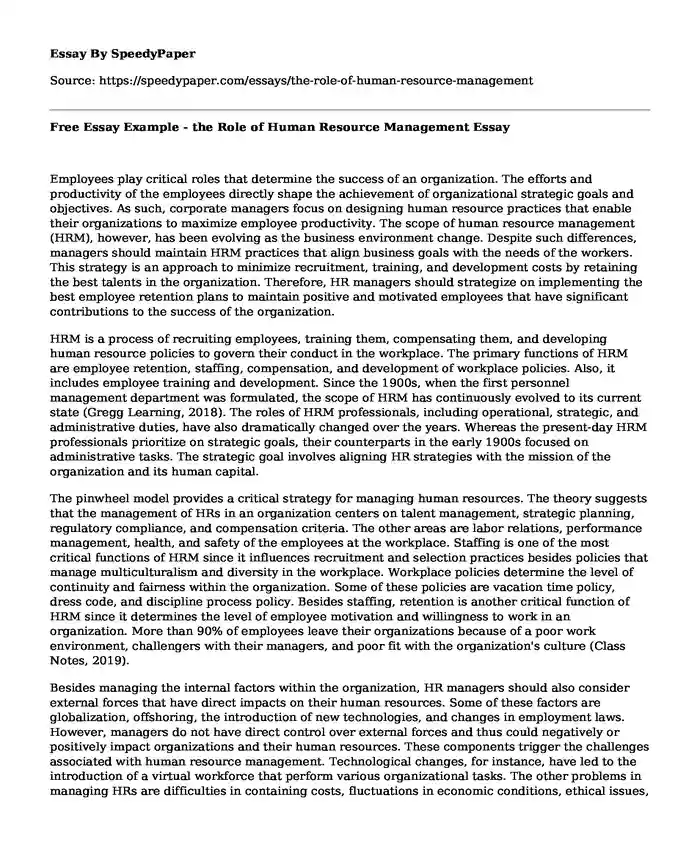
| Type of paper: | Essay |
| Categories: | Management Human resources Employment |
| Pages: | 3 |
| Wordcount: | 599 words |
Employees play critical roles that determine the success of an organization. The efforts and productivity of the employees directly shape the achievement of organizational strategic goals and objectives. As such, corporate managers focus on designing human resource practices that enable their organizations to maximize employee productivity. The scope of human resource management (HRM), however, has been evolving as the business environment change. Despite such differences, managers should maintain HRM practices that align business goals with the needs of the workers. This strategy is an approach to minimize recruitment, training, and development costs by retaining the best talents in the organization. Therefore, HR managers should strategize on implementing the best employee retention plans to maintain positive and motivated employees that have significant contributions to the success of the organization.
HRM is a process of recruiting employees, training them, compensating them, and developing human resource policies to govern their conduct in the workplace. The primary functions of HRM are employee retention, staffing, compensation, and development of workplace policies. Also, it includes employee training and development. Since the 1900s, when the first personnel management department was formulated, the scope of HRM has continuously evolved to its current state (Gregg Learning, 2018). The roles of HRM professionals, including operational, strategic, and administrative duties, have also dramatically changed over the years. Whereas the present-day HRM professionals prioritize on strategic goals, their counterparts in the early 1900s focused on administrative tasks. The strategic goal involves aligning HR strategies with the mission of the organization and its human capital.
The pinwheel model provides a critical strategy for managing human resources. The theory suggests that the management of HRs in an organization centers on talent management, strategic planning, regulatory compliance, and compensation criteria. The other areas are labor relations, performance management, health, and safety of the employees at the workplace. Staffing is one of the most critical functions of HRM since it influences recruitment and selection practices besides policies that manage multiculturalism and diversity in the workplace. Workplace policies determine the level of continuity and fairness within the organization. Some of these policies are vacation time policy, dress code, and discipline process policy. Besides staffing, retention is another critical function of HRM since it determines the level of employee motivation and willingness to work in an organization. More than 90% of employees leave their organizations because of a poor work environment, challengers with their managers, and poor fit with the organization's culture (Class Notes, 2019).
Besides managing the internal factors within the organization, HR managers should also consider external forces that have direct impacts on their human resources. Some of these factors are globalization, offshoring, the introduction of new technologies, and changes in employment laws. However, managers do not have direct control over external forces and thus could negatively or positively impact organizations and their human resources. These components trigger the challenges associated with human resource management. Technological changes, for instance, have led to the introduction of a virtual workforce that perform various organizational tasks. The other problems in managing HRs are difficulties in containing costs, fluctuations in economic conditions, ethical issues, changes in the labor market, and workforce diversity.
Conclusively, HRM plan is essential since it highlights critical areas in managing human resources. Managers, however, face challenges that result from differences in employee expectations and implementation of organizational objectives. Thus, managers should formulate strategic plans that promote alignment of HR functions and the needs of the organization.
References
Class Notes. (2019). The Role of Human Resources [Power Point Presentation].Gregg Learning. (2018, October 1). HR Basics: Human Resource Management.
Retrieved September 23, 2019, from https://www.youtube.com/watch?v=A2HFusWQIeE/url/
Cite this page
Free Essay Example - the Role of Human Resource Management. (2023, Feb 16). Retrieved from https://speedypaper.net/essays/the-role-of-human-resource-management
Request Removal
If you are the original author of this essay and no longer wish to have it published on the SpeedyPaper website, please click below to request its removal:
- Essay Example on Training Assessment
- Hurricane Matthew Effects
- Free Essay Sample on the Madrars-Khanqah of Sultan Al-Ashraf Barsbay
- Comparing Qualitative and Quantitative Research Methods. Free Essay.
- Free Essay Sample on How to Deliver a Speech Without Losing Interest in the Audience
- Desiree's Baby Response Paper, Free Sample for You
- Siemens' Case Study Paper Example
Popular categories




